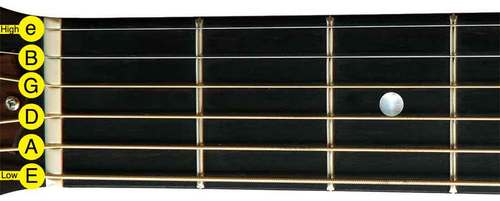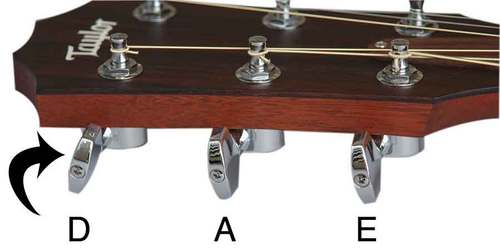Tune Your Guitar
There are many, many ways to tune your guitar . On this page I'll cover what is probably the most frequently used method by beginners: using a chromatic electronic tuner.
I've also provided an alternative guitar tuning methods page. You'll learn how to tune up when you don't have access to an electronic tuner.
A Few Basics
You should tune your guitar every single time you play. Here are a few reasons why:
- Hearing the notes in tune helps you tune the guitar. Though it sounds like circular reasoning, the more your ears hear in-tune strings the easier it becomes to tune your guitar.
- In-tune notes create in-tune chords. In tune chords increase your enjoyment of music. The more you enjoy the music you create, the more you will play.
- Tuning helps you learn the string names of your guitar and the note names at various frets. Reading and playing music then become more natural, so you play more!
What Notes Are You Aiming For?
Before you can tune your guitar, you need to know what notes you're supposed to end up with. The set of notes most frequently used for playing open chords are called 'standard tuning'.
Standard tuning on a six string guitar uses the notes: E, A, D, G, B, and E (lowest to highest tone). Don't let the fact that the note name 'E' is used twice. They are different pitches (more is explained below), and you'll often hear them described as "Low-E" and "High-E". (Learn more about notes and strings on our Guitar String Names page).
The descriptions on this page assume that you're hoping to achieve standard-tuning, and that you're right handed (if you're left handed, you're probably already used to mentally switching the terms I use).
There are other ways to tune your guitar. You'll eventually hear about tunings such as: Drop-D, Open-G, or 1/2-step de-tuning. Don't worry about those yet.
What is an Electronic Chromatic Tuner? Why use one?
The most frequently used device to tune your guitar is a chromatic electronic tuner.
It's 'electronic': The controlling device includes a digital sensor that can determine the pitch your string produces. A micro-computer compares that to a known in-tune pitch, and then produces a display to show how close your note is to the nearest 'in-tune' pitch.
It's 'chromatic': It can detect minor differences in pitch, and determine the nearest note in a wide range. Thanks to this feature, the tuner can let you know if your string is properly tuned to almost any playable note. A non-chromatic tuner works only with a specific set of notes.
It's a 'tuner': The electronics work with visible indicators (typically lights and/or a digital meter) to let you know if you need to increase your pitch, or decrease your pitch, to match a note.
Most tuners today allow you to adjust the reference-pitch (you will usually read references mentioning 440 Hz in your manual). For now, leave that alone. In the future, you may need to change your tuning slightly to accommodate an out of tune keyboard, for example. I talk more about this feature below.
An electronic chromatic tuner is very efficient, very accurate, fits in your pocket, and many can be purchased for as less than $20.
For more information on tuners, see the Guitar Tuners Guide.
Let's Get Started..
This description of how to tune your guitar assumes you have an electronic tuner. Most tuners 'hear' your guitar when you plug in your guitar cable, or using a built-in microphone. There are also tuners that produce a strobe so you can see when the string is in tune, and others that sense the vibration of your string by attaching to your guitar, usually to the headstock. For this article, I assume you have a tuner that uses allows you to plug in, or has a built-in microphone, such as the Korg CA-30.
If you have an acoustic guitar, simply keep the tuner close to you (in a noisy room, you may need to bring it very close, or lay it on the waist of the guitar body), so the built-in microphone can detect your guitar string over ambient noise in the room.
If you have an electric guitar, you'll need to plug a cable into your guitar, and plug the other end into the tuner to enable the tuner to 'hear' the note.
Begin by plucking the sixth string (the low-E) with the same force you'll use when you play.
 |
Most tuners will respond by showing:
- The name of the note (which will match the name of the string only if you're already close to being in tune).
- An indication that the note is too low, too high, or in-tune (see the illustration below).
 |
First check the note name. Since you're trying to tune your low E string, the name should be "E". If it's not, you need to tune up or down to get close enough to the right pitch that the tuner indicates "E".
Be careful! If you tune way too low (the next lower E) the string will begin striking the fretboard and you'll know that you need to tune UP to the correct E. If you tune way too high you will put significant tension on the string, or undue pressure on the structure of your guitar. You might break the string, or potentially damage your guitar. Also, when a guitar string breaks it can snap with a lot of force, so be careful.
If you are uncertain of which direction to tune, try using a reference tone to get close. Most tuners will play the tone "Concert A" which is higher than the E you're tuning to. The concert A note is the same as the pitch created when you press your finger on the fifth fret of the low E string. Tune up or down until the A-note you hear from the tuner is similar to the A-note on your guitar.
From there, make minor adjustments with your tuning key until the tuner indicates that the note is in tune (see the tuner on the right side of the illustration, above).
Why Would You Want To Adjust An Electronic Tuner?
An electronic tuner uses known frequencies to indicate when a string matches the desired note. The standardized pitches are:
- 329.6 Hz for String 1 (High e)
- 246.9 Hz for String 2
- 196.0 Hz for String 3
- 146.8 Hz for String 4
- 110.0 Hz for String 5
- 82.4 Hz for String 6 (Low E)
Usually you'll tune your guitar to this set of standard pitches, but not always. You may want to use an alternate tuning method, such as Drop-D or Open-G. You might also intentionally tune up or down slightly.
Why would you intentionally tune so that your guitar is 'out of tune'? Well... Suppose you play with a group of friends and it turns out that the keyboard player's instrument plays Concert A at 449 Hz? He probably can't change that, but you can intentionally tune slightly higher. Most electronic tuners even allow you to change the definition of Concert Pitch for situations like this. Read the instruction manual for additional details.
Important Tuning Tips!
Tune UP, Not Down
Do you ever tune your guitar, play for a few minutes, then have to tune again? You can usually eliminate this problem if you always start with a LOWer (flat) pitch, and then tune UP.
Why?
Friction!
Let's imagine that your guitar is tuned too high (sharp). This means the string is too tight. You need to loosen it, and the pitch drops until the string is in perfect tune.
Unfortunately, friction at the nut will tend to hold some tension on the string while you loosen it. Some of that tension holds the string until after you start playing. One you start playing the tension is released, and the string is now flat (too low).
The only way to avoid this it to intentionally turn your tuning key until the string is slightly flat, then slowly tune UP until the pitch is correct.
 |
Keep Your Strings Clean...
At best dirty strings produce a muted sound. At their worst they can be impossible to keep in tune.
Why?
On a six-string guitar, the lower three strings have a metal winding. Dirt from your fingers and the environment becomes embedded in these windings. This reduces the ability of the string to vibrate, which in turn makes it hard to tune and ruins the tone. Dirt also contributes to corrosion, another enemy of tone.
How can you avoid these problems?
Wash your hands before you play, and wipe your strings off with a soft, clean cloth every time you play.
Consider using coated strings (I recommend Elixir Strings or D'Addario EXP's). Although they are a bit more expensive per set, the coating protects the wound strings from problems caused by dirt, resulting in longer string life.
Stabilize Them Quickly...
When you put new strings on your guitar, they will stretch. As they stretch, the pitch goes flat.
To eliminate this problem, simply get this stretching-out period over as quickly as possible. This is easily done. As soon as you change your strings and get them somewhat into tune, grab each one with your thumb and index finger and pull it away from the guitar a couple or so inches. S-T-R-E-T-C-H it a few times (but don't put a lot of force on it). Then re-tune your guitar. Then stretch them again. Do this three or four times. Voila! Stable strings!
Watch out for the Whammy Bar!
Using the whammy bar, or tremolo bar, can be lots of fun... but on some guitars the whammy bar will quickly throw your strings out of tune. That is, after all, exactly what the whammy bar does... and on some guitars you'll have to tune your guitar again at the end of the song.
A quick experiment will tell you if this applies to your guitar. Tune up, then strum your guitar and use the whammy bar. Strum some more, then re-check your tuning.
If it's off just a little, no big deal. Experiment a bit to see if you can bring it back into tune by knowing where to leave the whammy bar.
If it's way off, you might want to have a technician look at it... there may be a problem. Otherwise, you'll just have to keep a tuner with you and tune your guitar again.
A Properly Etched Nut...
If you've looked at the glossary, you know that the nut is the fulcrum at the top of the guitar neck, holding the strings off the neck and body of the guitar.
Why do you care? Because an improperly etched nut will make it difficult to tune your instrument.
How can you tell? If you have repeated problems with strings going flat soon after you tune up, or if you hear your strings 'pop' as you tune.
This problem is especially evident if you use thicker strings or strings not recommended by the manufacturer. You will tune your guitar, and several minutes later one or more strings will be flat, even with strings that are neither brand new nor worn out. You may need to take your guitar to the shop and ask a technician to check it. Don't do this yourself unless you are experienced.
Looking For A Tuner? There A Lots To Choose From
Take a look at our growing selection and pricing.


